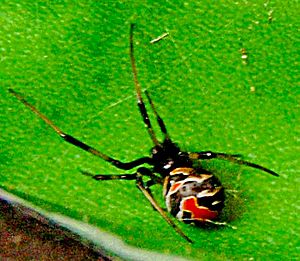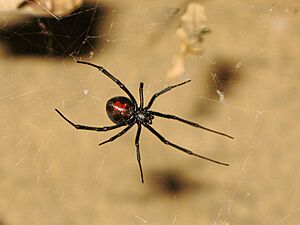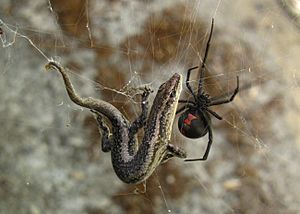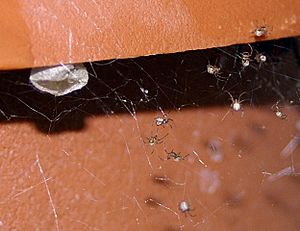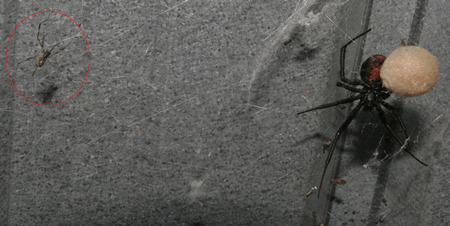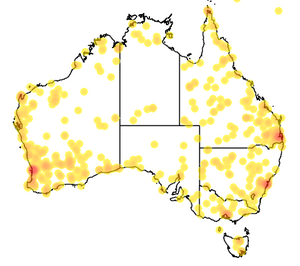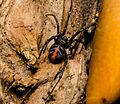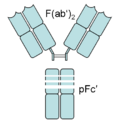Redback spider facts for kids
Quick facts for kids Redback spider |
|
|---|---|
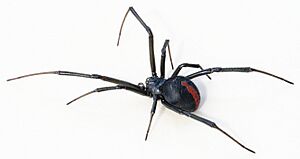 |
|
| An adult female redback spider. | |
 |
|
| An adult male, which is much smaller than the female. | |
| Scientific classification |
The redback spider (Latrodectus hasselti), also known as the Australian black widow, is a very venomous spider. It is thought to have first come from Australia. Now, you can find it in places like Southeast Asia and New Zealand. It has even traveled to other countries by accident, often hidden in shipping crates.
The redback spider belongs to a group called Latrodectus, which includes all widow spiders. The adult female is easy to spot. She has a shiny black body with a bright red stripe on her back. On her belly, she has a red or orange mark shaped like an hourglass. Female redbacks are about 10 millimeters long. The male is much smaller, only about 3 to 4 millimeters long.
Redback spiders are mostly active at night. The female builds a messy web in warm, safe places, often near or inside houses. She eats insects, other spiders, and even small animals like lizards that get caught in her web.
To catch her food, she bites it with her two fangs, injecting a strong venom. Then, she wraps the prey in silk and sucks out its insides. The redback is one of the few spiders in Australia that can be seriously harmful to humans. Because it likes to live near people, it causes many spider bites. A special medicine called antivenom was made in 1956 to treat these bites.
Contents
About the Redback Spider
The redback spider gets its name from the red stripe on its back. It is a close relative of other famous widow spiders, like the black widow in North America and the katipō in New Zealand.
A Swedish scientist named Tamerlan Thorell first described the redback spider in 1870. For many years, scientists wondered if the redback was its own species or a type of black widow. But today, DNA studies have shown that the redback is indeed its own unique species.
What Do Redback Spiders Look Like?
An adult female redback spider has a body about 1 centimeter long. Her main body part, called the abdomen, is shiny black. It has the famous red stripe on top and an hourglass shape underneath. Sometimes, a female might be brownish or not have a stripe at all. Her head and fangs, called the cephalothorax, are much smaller than her abdomen.
Young redback spiders are grey with dark spots. They get darker each time they shed their skin as they grow. Young females also have extra white markings on their abdomens. These bright colors might warn predators to stay away.
The male redback is tiny compared to the female. He is light brown with white markings on his back. He also has a pale hourglass shape on his belly.
How Redback Spiders Behave
Redback spiders are nocturnal, which means they are active at night. The female usually stays hidden during the day and builds her web at night. She often lives in the same spot for most of her life.
The Web
A redback's web looks like a messy tangle of strong silk. Even though it looks random, it is very smart at catching prey. The back of the web has a funnel-shaped area where the spider hides with her egg sacs.
From this funnel, sticky threads run down to the ground. These threads act like tripwires. When an insect or small animal touches a thread, it gets stuck. The thread breaks from the ground and pulls the prey into the air. This makes it easier for the spider to attack.
What Redbacks Eat
Redbacks mostly eat insects. But their strong webs can also trap bigger animals like small lizards and, very rarely, even snakes. They are often found near homes because lights and garbage attract insects, which are the spiders' main food source.
When prey is caught, the redback comes closer and squirts a sticky liquid silk to stop it from moving. Then, she bites the victim many times and wraps it in more silk. The venom turns the prey's insides into liquid, which the spider then sucks out.
Male spiders and young spiderlings sometimes live near the female's web and eat her leftovers.
The Life Cycle of a Redback Spider
After mating, the female can store the male's sperm for up to two years. She can use it to fertilize several groups of eggs. She lays her eggs in a white, round, silk sac. Each sac holds about 250 eggs.
Spiderlings hatch after about 8 days. They stay inside the egg sac for about a week, then come out. Male spiders become adults in about 45 to 90 days. Females take longer, about 75 to 120 days. Females can live for two to three years, but males only live for about six or seven months.
Young spiders leave their mother's web by a process called "ballooning." They climb to a high point, let out a long thread of silk, and let the wind carry them away to a new home.
Reproduction
When a male spider finds a female, he does a strange courtship dance. During mating, the male does a "somersault" and places his abdomen near the female's fangs. Most of the time, the female eats the male while they are mating.
This sacrifice helps the male in two ways. First, it lets him mate for a longer time, which means he can fertilize more of her eggs. Second, a female who has eaten a male is less likely to mate with another male. This helps make sure the first male's genes are passed on.
Where Do Redback Spiders Live?
The redback spider is found all over Australia. It originally lived in the dry parts of South and Western Australia. However, it has spread with human help.
Redbacks love living in and around human homes. They build their webs in dry, dark, and safe places. Common spots include sheds, under toilet seats, in empty cans, inside old tires, and in piles of wood or bricks. They are also found in mailboxes and children's toys left outside.
Because they travel well in cargo, redbacks have spread to other countries. They have started new groups in New Zealand, Japan, and the United Arab Emirates. They have also been found in greenhouses in Belgium.
Bites and Treatment
The redback spider is one of Australia's most well-known venomous creatures. The larger female is responsible for almost all bites to humans. The male is much smaller, and his bite usually causes only mild, short-lived pain.
Most bites happen during the warmer months. They often occur when someone accidentally puts their hand or foot near a spider's web. This can happen when gardening or cleaning up messy areas.
Venom and Symptoms
A redback's venom has a powerful toxin that affects the nervous system. This is called a neurotoxin. A bite from a redback can cause a condition called latrodectism.
The bite itself might feel like a small pinprick. Within an hour, strong pain can start at the bite spot. The area might also begin to sweat. Pain, redness, and swelling can spread up the arm or leg. Other symptoms can include feeling sick to your stomach, throwing up, headache, and high blood pressure. Severe pain can last for more than 24 hours.
While very painful, redback bites are usually not life-threatening for healthy adults. Children and older people are at a higher risk of more severe symptoms.
How Bites Are Treated
For most bites, simple first aid is enough. Putting an ice pack on the area and taking pain medicine like paracetamol can help. You should not put a tight bandage on the bite, as this can make the pain worse.
If the pain is very bad or if symptoms affect the whole body, you should go to a hospital. Doctors may use stronger pain medicine to help.
A special medicine called antivenom for redback bites has been available since 1956. In the past, it was given to anyone with severe symptoms. Today, doctors are more likely to manage the pain with other medicines first. No deaths from redback bites have been confirmed in Australia since the antivenom was introduced.
Redback Spiders in Popular Culture
The redback spider is a well-known symbol in Australia.
- The country singer Slim Newton had a hit song in 1973 called "The Redback on the Toilet Seat."
- A giant sculpture of a redback spider is one of Australia's big things and can be found in Queensland.
- The spider has been used as a logo for sports teams, a brand of beer, and a company that makes work boots.
Images for kids
See also
 In Spanish: Araña de lomo rojo para niños
In Spanish: Araña de lomo rojo para niños


